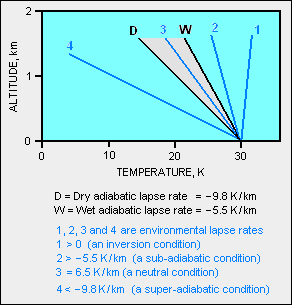User:Milton Beychok/Sandbox: Difference between revisions
imported>Milton Beychok |
imported>Milton Beychok No edit summary |
||
| Line 25: | Line 25: | ||
|align=right|where: | |align=right|where: | ||
|- | |- | ||
|align=right|<math>\Gamma_d</math> | |align=right|<font style="vertical-align:-10%;"><math>\Gamma_d</math></font> | ||
|align=left|= the dry adiabatic lapse rate | |align=left|= the dry adiabatic lapse rate | ||
|- | |- | ||
|align=right|<math>g</math> | |align=right|<font style="vertical-align:-45%;"><math>g</math></font> | ||
|align=left|= Earth's [[gravitational acceleration]], 9.8076 m/s<sup>2</sup> | |align=left|= Earth's [[gravitational acceleration]], 9.8076 m/s<sup>2</sup> | ||
|- | |- | ||
|align=right|<math>c_p</math> | |align=right|<font style="vertical-align:-40%;"><math>c_p</math></font> | ||
|align=left|= the [[specific heat]] of air at constant pressure | |align=left|= the [[specific heat]] of air at constant pressure | ||
|} | |} | ||
Revision as of 15:37, 24 August 2009
The atmospheric lapse rate ( ) refers to the change of an atmospheric variable with a change of altitude, the variable being temperature unless specified otherwise (such as pressure, density or humidity).[1] While usually applied to Earth's atmosphere, the concept of lapse rates can be extended to atmospheres (if any) that exist on other planets.
Lapse rates are usually expressed as the amount of temperature change associated with a specified amount of altitude change, such as – 9.8 K per kilometre, – 0.0098 K per metre or the equivalent – 5.4 °F per 1000 feet. If the atmospheric air cools with increasing altitude, the lapse rate is expressed as a negative number. If the air heats with increasing altitude, the lapse rate is expressed as a positive number. In the lowest layer of the [[Earth's atmosphere], named the troposphere, which extends from Earth's surface to an altitude of about 7 to 11 km (4 to 11 mi), the temperature of the atmospheric air usually cools.
The lapse rate is most often denoted by the Greek capital letter Gamma, or Γ,[2] but not always. For example, the U.S. Standard Atmosphere uses L to denote lapse rates:[3] A few others use the Greek lower case letter gamma, , which is an unfortunate choice since gamma is also used for the specific heat ratio.
Types of lapse rates
There are three types of lapse rates that are used to express the rate of temperature change with a change in altitude, namely the dry adiabatic lapse rate, the wet adiabatic lapse rate and the actual ambient lapse rate.
Dry adiabatic lapse rate
Since the atmospheric pressure decreases with altitude (see Earth's atmosphere), the volume of an air parcel expands as it rises. Conversely, if a parcel of air sinks from a higher altitude to a lower altitude, its volume is compressed by the higher pressure at the lower altitude. An adiabatic lapse rate is the rate at which the temperature of an air parcel changes in response to the expansion or compression process associated with a change in altitude, under the assumption that the process is adiabatic (meaning that no heat is added or lost during the process).
Earth's atmospheric air is rarely completely dry. It usually contains some water vapor and when it contains as much water vapor as it is capable of, it is referred to as saturated air (i.e., it has a relative humidity of 100%). The dry adiabatic lapse rate refers to the lapse rate of unsaturated air (i.e., air with a relative humidity of less than 100%). It is also often referred to as the dry adiabat or as the DALR.
The dry adiabtic lapse rate can be mathematically expressed as:
| where: | |
| = the dry adiabatic lapse rate | |
| = Earth's gravitational acceleration, 9.8076 m/s2 | |
| = the specific heat of air at constant pressure |
References
- ↑ The lapse rate is often defined as the negative change of temperature with a change of altitude. That definition leads to statements such as "A positive lapse rate indicates cooling as height increases while a negative lapse rate indicates warming as height increases". That is counter-intuitive since lapse rates are usually denoted as a negative number (i.e., - 6.5 K/km) to indicate cooling with an increase of height.
- ↑ is the LaTex rendition and Γ is the HTML rendition.
- ↑ U.S. Standard Atmosphere, 1976
Hold items
- Mark Zachary Jacobson (2005). Fundamentals of Atmospheric Modeling, 2nd. Cambridge University Press. ISBN 0-521-83970-X. </ref>
- C. Donald Ahrens (2006). Meteorology Today, 8th. Brooks/Cole Publishing. ISBN 0-495-01162-2. </ref>






